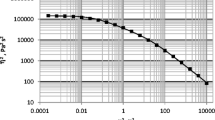Abstract
A generalization of Newton’s formula for shear stress in a fluid is carried out by giving it a power-law form and the corresponding rheological relation is written in tensor form. Depending on the exponent in this rheological ratio, one can come to a description of either a laminar or turbulent flow regime. In the latter case, there is a system of differential equations with the no-slip boundary condition. The proposed set of equations for turbulent fluid motion can be useful, at least, for obtaining preliminary, estimated characteristics of turbulent flow before starting numerical modeling using modern differential turbulence models. For some values of the exponent, this system can be used to describe the behavior of power-law fluids as well as fluids with small additives of polymers in the manifestation of the Toms effect.

Similar content being viewed by others
REFERENCES
L. S. Artyushkov, Dynamics of Non-Newtonian Fluids (S.-Peterb. Gos. Morsk. Tekh. Univ., St. Petersburg, 1997) [in Russian].
H. Oertel, Jr., Prandtl’s Essentials of Fluid Mechanics (Vieweg, Braunschweig, 2001; Springer-Verlag, New York, 2003; Regulyarnaya Khaoticheskaya Din., Moscow, 2007).
L. G. Loitsyanskii, Mechanics of Liquid and Gas (Nauka, Moscow, 1987) [in Russian].
G. I. Barenblatt, A. J. Chorin, and V. M. Prostokishin, “Turbulent flows at very large Reynolds numbers: New lessons learned,” Phys. Usp. 57, 250–256 (2014).
I. I. Vigdorovich, “Does the power formula describe turbulent velocity profiles in tubes?,” Phys. Usp. 58, 196–198 (2015).
N. Zh. Dzhaichibekov, S. K. Matveev, and D. G. Sidorov, “Calculation of stratified two-phase flow in a pipe,” Vestn. S.-Peterb. Univ., Ser. 1: Mat., Mekh., Astron. 4(62), 131–135 (2017). https://doi.org/10.21638/11701/spbu01.2017.115
V. A. Pavlovskii and D. V. Nikushchenko, Computational Fluid Dynamics. Theoretical Basis (Lan’, St. Petersburg, 2018) [in Russian].
ACKNOWLEDGMENTS
This study was carried out within the framework of the state task for the implementation of research works no. 075-03-2020-094/1 of June 10, 2020.
Author information
Authors and Affiliations
Corresponding author
Additional information
Translated by K. Gumerov
About this article
Cite this article
Pavlovsky, V.A. Power-Law Generalization of Newton’s Formula for Shear Stress in a Liquid in the Form of a Tensor Rheological Relation. Vestnik St.Petersb. Univ.Math. 55, 229–234 (2022). https://doi.org/10.1134/S1063454122020091
Received:
Revised:
Accepted:
Published:
Issue Date:
DOI: https://doi.org/10.1134/S1063454122020091




